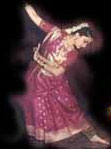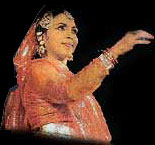 Kathak is the major dance style of northern India and combines local folk elements with dance forms that developed in the courts of the Mughal emperors and later Indian princes . During the 15th and 16th centuries, Kathak assumed a distinct dance form. This was due to the popularization of the Radha Krishna legend and consequent emergence of an operatic play known as 'Rasa Lila' which in turn was inspired by the song of big poets like Surdas, Nandadas and Krishnadas with the advent of the muslim rule.
Kathak is the major dance style of northern India and combines local folk elements with dance forms that developed in the courts of the Mughal emperors and later Indian princes . During the 15th and 16th centuries, Kathak assumed a distinct dance form. This was due to the popularization of the Radha Krishna legend and consequent emergence of an operatic play known as 'Rasa Lila' which in turn was inspired by the song of big poets like Surdas, Nandadas and Krishnadas with the advent of the muslim rule.
 The folk and temple traditions from which the Kathak style has developed consist mostly of Hindu dance-dramas. Kathak owes much of its present form to developments made in the 1800's at the court of Nawab Wajid Ali Shah, the ruler of Lucknow.
The folk and temple traditions from which the Kathak style has developed consist mostly of Hindu dance-dramas. Kathak owes much of its present form to developments made in the 1800's at the court of Nawab Wajid Ali Shah, the ruler of Lucknow.
Dancers perform Kathak keeping their bodies straight. Clever footwork, including highly rhythmical walks, glides, and fast pirouettes (spinning on one foot), gives the style its vital, dazzling, skilful character. Delicate movements of the eyes, eyebrows, neck, and shoulders are also used in some dances. Both men and women perform Kathak dances. Many dances express love or devotion to Krishna.



